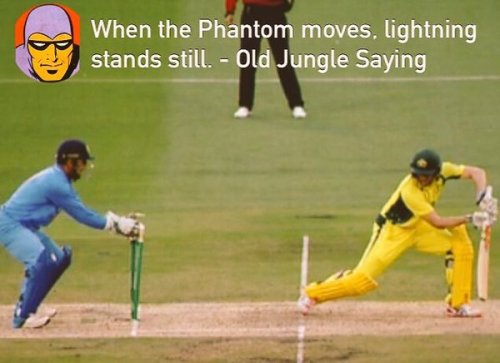I don’t often write about physics here, but when I do it’s because I remember what my favorite physics teacher had told me – to keep find physics in the everyday. Given that I spend a heck of a lot of time following sports, everyday does turn out to be sports.
Eariler in the day today, Indian T20 captain and wicketkeeper M S Dhoni effected his 140th stumping, thus establishing a world record for most stumpings in international cricket matches (89 in ODIs, 13 in T20s and 38 in Tests).
In the T20 match between India and Australia at the MCG today, his first stumping of Glenn Maxwell off Yuvraj Singh was particularly impressive because he hardly had any reaction time. Cricket writer @Sampath_B24 posted a nice slow motion video of the dismissal with the claim that the reaction time was 0.1 seconds.
https://twitter.com/SAMPATH_B24/status/693042089244778496
But Sampath was worried about the veracity of his number so I did a little bit of digging.
First, a quick primer on slow motion – essentially slow motion is video that was shot at a much faster rate (say a camera took 120 frames per second (fps) to construct a picture) but then played back at a much slower frame rate. Ordinary film is recorded at 24 fps so what we call video is really a set of pictures rapidly shuffling before us, much like a flipbook.
Remember Ishaan’s in Taare Zameen Par?
https://twitter.com/The_AKFC/status/678867748965908480
But if we play that back in slow motion we might find that there is a lot of blurring because pictures of high speed sporting action may have missed microsecond transitions.
The puzzle for me was to time how much time Dhoni had to react i.e. from the time the ball reached his gloves to him taking the bails off. Of course I had joked during the one day series where he made another smart stumping that:

But this had to pass scientific scrutiny. Unfortunately the broadcaster had not given us the reaction time (like they sometimes do when they show a good reflex catch being taken) but Sampath’s 16 second clip had enough clues to check at least crudely if his claim of 0.1 second was broadly correct.
I asked my go to physics person on twitter and he said sports cameras usually record at about 120 fps.
I confirmed that from an ABC page on how slow motion works and confirmed the general math with another article on baseball physics. So assuming the Channel 9 cameras covering the game at the MCG were recording at 120 fps (the broadcast standard) and playing it at 1/5 the speed (24 fps), the real time as compared to what you see in the video should be 5 times faster.
I timed Dhoni’s reaction time and on the slow-mo according to my stopwatch it was between 0.5-0.6 seconds (I did this three times to get an average number to round off errors). The real time then would be 0.5 or 0.6 divided by 5 which is roughly between 0.1-0.12 seconds.
I am happy to report that Sampath’s eyeballed claim more or less stands. As does the general claim that Dhoni is one of the best when it comes to reaction times behind the wicket.
Maybe someone can look at this a little more scientifically and analyze some Dhoni slomo videos. Or just hand a physics class a project. That should, as with anything Dhoni touches, make physics just a tad bit more interesting.

Pingback: Dhoni and the art of delay | Get Sporty
Physics wasn’t my fav subject but this is really really interesting.
Well…it had to be ..after all it is Dhoni we are.talking about after all …right !